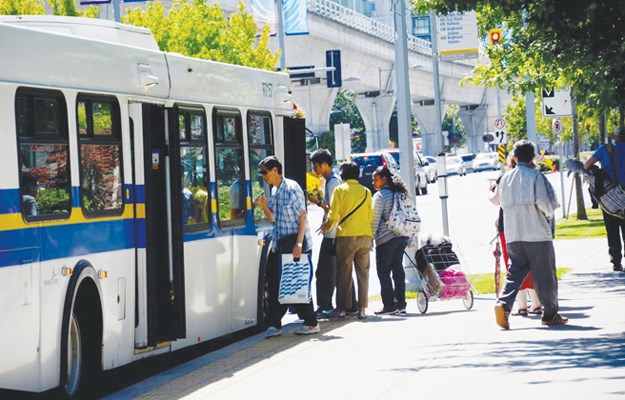A blueprint for transit changes for Richmond is expected to roll out by the end of the year, according to TransLink, which must still finalize proposals under its Southwest Area Transport Plan. No timeline has been set for that finalization and all initiatives are dependent on future funding. Regardless, here are some of the proposals:
404/405 diverted north-south
A faster, more direct link from north to south will come with a new 405 route that takes passengers all the way down No. 5 Road, from Bridgeport Station to Ironwood Business Park. And, the 404 will also run the entire length of No. 4 Road, down to Steveston Highway where it will circle around Ironwood and head back up to Bridgeport Station. These routes will better serve new developments in the Cambie neighbourhoods. But, the new routes eliminate some existing services along sparsely populated areas on Westminster Highway and Granville Avenue. Thus, some commuters will need to transfer.
403 split, C93 to London Landing
In terms of east-west travel, the C93 community bus remains the only non-transfer option in south Richmond. However, a transfer at Steveston Highway at No. 3 Road may soon be more convenient for some. That’s because the more frequent 403 (No. 3 Road bus) will have two new routes. One route will head west on Steveston Highway to the Village while the other route heads east to Riverport. This increases bus frequency on the west side of Steveston Highway but decreases it to the east. Notably, the C93 will extend to London Landing.
A semi-circuitous route from Steveston to Riverport may be possible via the new 401 schedule, as this route is proposed to branch out in two routes (one, long back-and-forth line) from Brighouse Station: 401e, via Garden City Road, and 401w, via No. 1 Road.
402/407 diverted for Blundell bus
A new Blundell Road bus is proposed from the West Dyke to Garden City Road and then north, looping around City Centre. This new route will allow the 402 to be diverted from Blundell to run north on No. 2 Road (where there is currently no service) to River Road, past the Richmond Olympic Oval, then to a planned Capstan Way Station.
Also being diverted from Brighouse Station will be the 407 (Gilbert Road) bus. Heading north, instead of turning right on Westminster Highway, the 407w bus will dart over the Dinsmore Bridge and serve Burkeville at Russ Baker Way. It will then terminate at Bridgeport Station. Then, the new 407e will service Bridgeport Road’s industrial area, including Vulcan Way, and travel across to Knight Street and Marine Drive in Vancouver. With a more frequent 407w to Burkeville, it will mean the C92 on Sea Island will be cancelled.
410 Railway will be less frequent
The classic West Richmond buses 401, 402 and 403 will form a “Frequent Transit Network” along their respective main drags. The 401w should run every seven minutes from its present nine during peak periods; the 407w will run every 15 minutes, down from every 20 during peak times; And the two 403 routes will combine for buses every 10 minutes up and down No. 3 Road. These more frequent routes will compensate for a slower Railway Avenue bus. The 410 will be split into 410w and 410e. This is expected to better serve commuters in east Richmond by increasing the 410e frequency. In exchange for this, TransLink intends to shut down the C96 due to lack of demand.
480 on chopping block for more trains
TransLink intends to install a B-Line bus to Metrotown, which may call on the 430 from Brighouse Station to be reviewed. As well, the 480 to University of B.C. is on the chopping block as ridership has been declining.
TransLink also expects to add more trains to the Canada Line to increase frequency over the next five years, as the line is now overcrowded. But, per media reports, it was recently noted by TransLink CEO Kevin Desmond at the Surrey Board of Trade this month that the Canada Line stations were underbuilt (so it is impossible to extend trains without costly platform extensions). Furthermore, increased frequency from Brighouse to Lansdowne stations is hampered by a single track.



